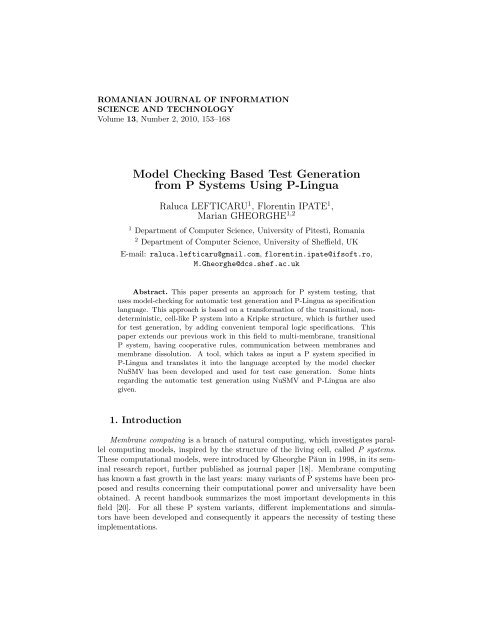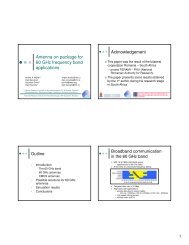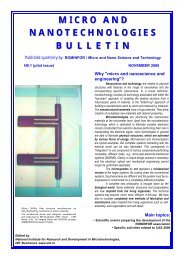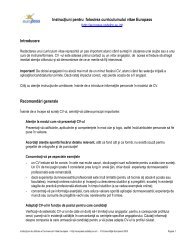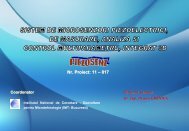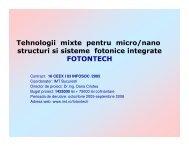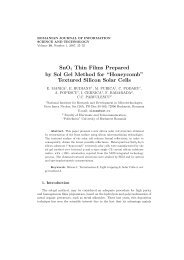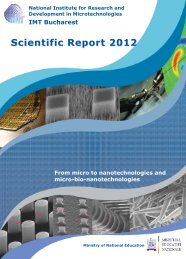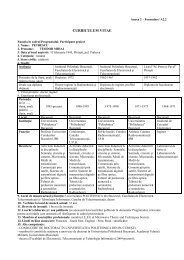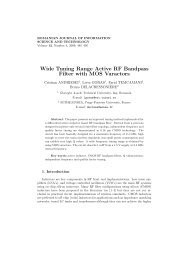Model Checking Based Test Generation from P Systems Using ... - IMT
Model Checking Based Test Generation from P Systems Using ... - IMT
Model Checking Based Test Generation from P Systems Using ... - IMT
Create successful ePaper yourself
Turn your PDF publications into a flip-book with our unique Google optimized e-Paper software.
ROMANIAN JOURNAL OF INFORMATIONSCIENCE AND TECHNOLOGYVolume 13, Number 2, 2010, 153–168<strong>Model</strong> <strong>Checking</strong> <strong>Based</strong> <strong>Test</strong> <strong>Generation</strong><strong>from</strong> P <strong>Systems</strong> <strong>Using</strong> P-LinguaRaluca LEFTICARU 1 , Florentin IPATE 1 ,Marian GHEORGHE 1,21 Department of Computer Science, University of Pitesti, Romania2 Department of Computer Science, University of Sheffield, UKE-mail: raluca.lefticaru@gmail.com, florentin.ipate@ifsoft.ro,M.Gheorghe@dcs.shef.ac.ukAbstract. This paper presents an approach for P system testing, thatuses model-checking for automatic test generation and P-Lingua as specificationlanguage. This approach is based on a transformation of the transitional, nondeterministic,cell-like P system into a Kripke structure, which is further usedfor test generation, by adding convenient temporal logic specifications. Thispaper extends our previous work in this field to multi-membrane, transitionalP system, having cooperative rules, communication between membranes andmembrane dissolution. A tool, which takes as input a P system specified inP-Lingua and translates it into the language accepted by the model checkerNuSMV has been developed and used for test case generation. Some hintsregarding the automatic test generation using NuSMV and P-Lingua are alsogiven.1. IntroductionMembrane computing is a branch of natural computing, which investigates parallelcomputing models, inspired by the structure of the living cell, called P systems.These computational models, were introduced by Gheorghe Păun in 1998, in its seminalresearch report, further published as journal paper [18]. Membrane computinghas known a fast growth in the last years: many variants of P systems have been proposedand results concerning their computational power and universality have beenobtained. A recent handbook summarizes the most important developments in thisfield [20]. For all these P system variants, different implementations and simulatorshave been developed and consequently it appears the necessity of testing theseimplementations.
154 R. Lefticaru et al.A first approach on testing P systems focuses on cell-like models and proposessome coverage criteria [11], which are empirically evaluated in [15]. Automatic testgeneration for P systems using model-checking is proposed in [14].Given a model of a system, model checking [6] is a formal verification techniquethat explores the entire state space and decides whether this model meets a givenproperty, expressed in temporal logic. If the property does not hold, then a counterexampleis returned. This capability of model checkers to construct counterexamplesprovides a way to build test sets. Fraser et al. present in a recent and comprehensivesurvey [9] the results obtained over the last decade in software testing using modelcheckers.One of the approaches used to obtain a test suite using model checking follows thesteps [9]:1. A test purpose is defined, describing the expected features of the test case,for example: reaching a certain state s in the model, covering a transition t,traversing a sequence of states, getting a certain value val of a variable x, etc.2. These features are further specified as temporal logic properties and then convertedby negation into never-claim conditions, or trap properties, such as:G !(state = s), expressing that the system will never reach state s, or G !(x =val), expressing that the value val is never taken (x is always different <strong>from</strong>val).3. The model checker will verify whether the never-claim or trap property holds.If the property is false, it returns a counterexample that gives the exact pathin the model which satisfies the test purpose, e.g., reaches state s or sets thesystem variable x to val. The counterexample will provide all the informationneeded to extract the test case. If the property is true, then it is impossible tobuild a test case satisfying the given purpose.Regarding P system testing, one intuitive test criterion is rule coverage, that specifiesthat the test set should contain test cases which cover every rule, i.e., for eachrule there exists a test case, describing a computation which involves that rule. Morepowerful test sets can be computed by considering the context-dependent rule coveragecriterion. This considers coverage of rules in the context defined by other rules.An approach on building test cases for P systems using model checking was proposedin [14]. It transforms the P system specification into a Kripke structure, thenproperties regarding the coverage criteria are expressed in LTL (Linear TemporalLogic) and added to the NuSMV specification. This paper extends the work <strong>from</strong>[14] in the following aspects:• It employs the P-Lingua framework [10], to specify the P system and verify itssyntactic correctness.• It uses multi-membrane P systems, having cooperative and communication rulesbetween membranes (the approach presented in [14] treats only one-membraneP systems, with cooperative rules).
<strong>Model</strong> <strong>Checking</strong> <strong>Based</strong> <strong>Test</strong> <strong>Generation</strong> <strong>from</strong> P <strong>Systems</strong> 155• A transformation of P systems with membrane dissolution into the SMV (Symbolic<strong>Model</strong> Verifier) language is proposed.• Bounded model checking (BMC) is used to obtain the shortest counterexamples.This is useful in practice, to obtain a reduced test suite.• The paper shows how other properties can be verified against the transformedmodel, to find possible faults in the P system.2. BackgroundIn the rest of the paper, we will use the following notations: V ∗ for the set of allstrings over the alphabet V = {a 1 , ..., a p } and λ to denote the empty string. For astring u ∈ V ∗ , |u| ai denotes the number of a i occurrences in u. Each string u has anassociated vector of non-negative integers: Ψ V : V ∗ → N p , Ψ V (u) = (|u| a1 , ..., |u| ap ).2.1. P systemsA basic cell-like P system is defined as a hierarchical arrangement of membranesidentifying corresponding regions of the system. Each region has associated a finitemultiset of objects and a finite set of rules; both may be empty. A multiset is eitherdenoted by a string u ∈ V ∗ , where the order is not considered, or by Ψ V (u). Thefollowing definition refers to one of the many variants of P systems, namely cell-like Psystems, which use transformation and communication rules [19]. We will call theseprocessing rules. Since now onwards we will call this model P system.Definition 2.1. A P system is a tuple Π = (V, µ, w 1 , ..., w n , R 1 , ..., R n ), where Vis a finite set, called alphabet; µ defines the membrane structure, which is a hierarchicalarrangement of n compartments called regions delimited by membranes - thesemembranes and regions are identified by integers 1 to n; w i , 1 ≤ i ≤ n, representsthe initial multiset occurring in region i; R i , 1 ≤ i ≤ n, denotes the set of processingrules applied in region i.The membrane structure, µ, is a tree like structure represented by a string of leftand right brackets ([ i , and ] i ), each with the label of the membrane i, it points to;µ also describes the position of each membrane in the hierarchy. The rules in eachregion have the form u → (a 1 , t 1 )...(a m , t m ), where u ∈ V + is a multiset of symbols<strong>from</strong> V , a i ∈ V , t i ∈ {in, out, here}, 1 ≤ i ≤ m. When such a rule is applied toa multiset u in the current region, u is replaced by the symbols a i with t i = here;symbols a i with t i = out are sent to the outer region or outside the system when thecurrent region is the external compartment and symbols a i with t i = in are sent intoone of the regions contained in the current one, arbitrarily chosen. In the followingdefinitions and examples when the target indication is here, the pair (a i , here) willbe replaced by a i . The rules are applied in maximally parallel mode.A configuration of the P system Π, is a tuple c = (u 1 , ..., u n ), where u i ∈ V ∗ , isthe multiset associated with region i, 1 ≤ i ≤ n. A computation <strong>from</strong> a configuration
156 R. Lefticaru et al.c 1 to c 2 using the maximal parallelism mode is denoted by c 1 =⇒ c 2 . In the setof all configurations we will distinguish terminal configurations; c = (u 1 , ..., u n ) is aterminal configuration if there is no region i such that u i can be further developed.We say that a rule is cooperative if it has at least two objects in its lefthand side, e.g., ab → (c, in)(d, out). Otherwise, the rule is non-cooperative, e.g.,a → (c, in)(d, out). The rules can also have the form u → vδ, where δ denotes theaction of membrane dissolution: if the rule is applied, then the corresponding membranedisappears and its contents, object and membranes alike, are left free in thesurrounding membrane; the rules of the dissolved membrane disappear with the membrane.The skin membrane is never dissolved. For further details regarding membranecomputing, please refer to [19].2.2. P-LinguaP-Lingua is a programming language for membrane computing [8], developedby members of the Research Group on Natural Computing, at the University ofSeville. It is developed as a free software framework for cell-like P systems and canbe downloaded <strong>from</strong> http://www.p-lingua.org. Its main component is a Java library,pLinguaCore, that accepts as input text files (either in XML or in P-Lingua format)describing the P system model [10].The library includes several built-in simulators for each supported model. P-Lingua 2.0 was designed for cell-like P systems and contains simulators for the followingtypes of P systems: active membrane with division/creations rules, transition,symport/antiport, stochastic and probabilistic P systems. P-Lingua 2.1 (actual version)was extended for tissue P systems with symport/antiport rules and cell division[16].The P-Lingua software package contains the pLinguaCore library and a user interfacecalled pLinguaPlugin. It was used in several research papers, e.g., to solve aSAT problem using a family of P systems [8], to describe and simulate ecosystems bymeans of P systems [10].2.3. Kripke structuresDefinition 2.2. A Kripke structure over a set of atomic propositions AP is a fourtuple M = (S, H, I, L), where S is a finite set of states; I ⊆ S is a set of initial states;H ⊆ S × S is a transition relation that must be left-total, that is, for every states ∈ S there is a state s ′ ∈ S such that (s, s ′ ) ∈ H; L : S −→ 2 AP is an interpretationfunction, that labels each state with the set of atomic propositions true in that state.Usually, the Kripke structure representation of a system results by giving valuesto every variable in each configuration of the system. Suppose var 1 , . . . , var n arethe system variables, V al i denotes the set of values for var i and val i is a value <strong>from</strong>V al i , 1 ≤ i ≤ n. Then the states of the system are S = {(val 1 , . . . , val n ) | val 1 ∈V al 1 , . . . , val n ∈ V al n }, and the set of atomic predicates are AP = {(var i = val i ) |1 ≤ i ≤ n, val i ∈ V al i }. Naturally, L will map each state (given by the values of
<strong>Model</strong> <strong>Checking</strong> <strong>Based</strong> <strong>Test</strong> <strong>Generation</strong> <strong>from</strong> P <strong>Systems</strong> 157variables) onto the corresponding set of atomic propositions. For convenience, in thesequel the expressions of AP and L will not be explicitly given, the implication beingthat they are defined as above.2.4. NuSMVNuSMV is a symbolic model checker [3], developed as part of a joint projectbetween Carnegie Mellon University and Istituto per la Ricerca Scientifica e Tecnologica.NuSMV is the result of the reengineering, reimplementation, and, to alimited extent, extension of the SMV model checker [17]. It is publicly availableat http://nusmv.irst.itc.it/. NuSMV [3] can process files written in SMV (Symbolic<strong>Model</strong> Verifier) language [17]. The NuSMV language is mostly source compatiblewith the original version of SMV and it supports LTL (Linear Temporal Logic [21]and CTL (Computation Tree Logic) [5] as temporal specification logics.The input language of NuSMV was designed to allow descriptions of Finite StateMachines (FSMs), more precisely to describe the transition relation of the FSM. Forexample, considering a finite state machine with three states, {running, halt, crash}the transition relation of the FSM can be expressed also using the TRANS keyword asfollows:MODULE mainVARstate : {running, halt, crash};ASSIGNinit(state) := running;TRANSstate = running & next(state) = running |state = running & next(state) = halt |state = running & next(state) = crash |state = halt & next(state) = halt |state = crash & next(state) = crashHaving a model described in NuSMV, one can add LTL or CTL specifications tobe verified by the model checker. In LTL path properties can be expressed, havingatomic propositions as state subformulas. For example, if f and g are path formulas,then ¬f, f ∨ g, f ∧ g, Xf, Ff, Gf are path formulas, where: the X operator (”neXttime”) requires that a property holds in the next state of the path; the F operator(”eventually” or ”in the future”) is used to assert that a property will hold at somestate on the path and G (”always” or ”globally”) specifies that a property holds atevery state on the path. A complete list of LTL operators, can be found in [6].For the previous model, the specification LTLSPEC G !(F state = halt) is falseand the counterexample obtained is the path: running → halt → halt → . . . (thesystem will eventually remain in the halt state). On the other hand, the specificationLTLSPEC G !(state = halt & X state = running) is true (there is no transition<strong>from</strong> the halt state, having the next state running).
158 R. Lefticaru et al.3. Coverage criteria for P systemsA set of coverage criteria for P system rules, inspired <strong>from</strong> grammar testing,is presented in [11]. <strong>Test</strong> sets should be further designed to satisfy each coveragecriterion. In the following we summarize the main coverage criteria, but for simplicity,we will provide the definitions only for one membrane P systems, Π = (V, µ, w, R),µ = [ 1 ] 1 .Definition 3.1. A multiset denoted by u ∈ V ∗ , covers a rule r : a → v ∈ R, ifthere is a computation w =⇒ ∗ xay =⇒ x ′ vy ′ =⇒ ∗ u; x, y, x ′ , y ′ , v, u ∈ V ∗ , a ∈ V ,w ∈ V ∗ is the initial multiset. If there is no further computation <strong>from</strong> u, then this iscalled a terminal coverage.Definition 3.2. A set T ⊆ V ∗ , is called a test set that satisfies the rule coverage(RC) criterion if for each rule r ∈ R there is u ∈ T which covers r. If every u ∈ Tprovides a terminal coverage then T is called a test set that satisfies the rule terminalcoverage (RTC) criterion.Definition 3.3. A rule r ∈ R, r : a → ubv, u, v ∈ V ∗ , a, b ∈ V , is called a directoccurrence of b. For every symbol b ∈ V , we denote by Occs(Π, b), the set of all directoccurrences of b.Definition 3.4. A multiset z ∈ V ∗ covers the rule r : b → y ∈ R for the directoccurrence of b, a → ubv ∈ R, if there is a computation w =⇒ ∗ u 1 av 1 =⇒ u ′ 1ubvv 1′=⇒ u ′′1u ′ yv ′ v 1 ′′ =⇒ ∗ z; u, v, u ′ , v ′ , u 1 , v 1 , u ′ 1, v 1, ′ u ′′1, v 1 ′′ , y ∈ V ∗ , a, b ∈ V. A set T r is saidto cover r : b → y for all direct occurrences of b if for any occurrence o ∈ Occs(Π, b)there is t ∈ T r such that t covers r for o.Definition 3.5. A set T is said to achieve context-dependent rule coverage(CDRC) for Π if it covers all r ∈ R for all their direct occurrences. If every z ∈ T providesa terminal coverage then T is called a test set that satisfies the context-dependentrule terminal coverage (CDRTC) criterion.To illustrate these concepts, we consider the P system Π = (V, µ, w, R) where:V = {a, b, c}, µ = [ 1 ] 1 , w = a, R = {r 1 : a → bc; r 2 : b → bc; r 3 : b → c}. Itcan be verified that the set T = {c 3 } covers all the rules, because the computationa =⇒ bc =⇒ bc 2 =⇒ c 3 applies the rules r 1 , r 2 , r 3 . Note that c 3 is a terminalconfiguration and, consequently, T = {c 3 } satisfies the RTC criterion. The test setT ′ = {bc 2 , c 2 } achieves the CDRC criterion, because it covers the rules r 2 , r 3 , eachone in the context defined by r 1 . A test set satisfying the CDRTC is T ′′ = {c 2 , c 3 }.4. Transforming a one-membrane P systeminto a Kripke structureIn a previous paper [14], a transformation of a one-membrane P system into aKripke structure was proposed and several theoretical aspects were analysed. Tosimplify the presentation, we will consider here only one-membrane P systems and
<strong>Model</strong> <strong>Checking</strong> <strong>Based</strong> <strong>Test</strong> <strong>Generation</strong> <strong>from</strong> P <strong>Systems</strong> 159show in next section how this approach can be extended to a multi-membrane system.We assume that the universal clock governs the computation of the P system.Consider the one-membrane P system Π = (V, µ, w, R), where R = {r 1 , . . . , r m };each rule r i , 1 ≤ i ≤ m, is of the form u i −→ v i , where u i and v i are multisets over thealphabet V . In the sequel, we treat the multisets as vectors of non-negative integers,that is each multiset u is replaced by Ψ V (u) ∈ N k , where k denotes the number ofsymbols in V ; so, we will write u ∈ N k .In order to define the Kripke structure associated to Π we use two predicatesMaxP ar and Apply (similar to [7]): MaxP ar(u, u 1 , v 1 , n 1 , . . . , u m , v m , n m ), u ∈ N k ,n 1 , . . . , n m ∈ N signifies that a computation <strong>from</strong> the configuration u in maximallyparallel mode is obtained by applying rules r 1 : u 1 −→ v 1 , . . . , r m : u m −→ v m ,n 1 , . . . , n m times, respectively (in particular, MaxP ar(u, u 1 , v 1 , 0, . . . , u m , v m , 0) signifiesthat no rule can be applied and so u is a terminal configuration); Apply(u, v, u 1 ,v 1 , n 1 , . . . , u m , v m , n m ), u, v ∈ N k , n 1 , . . . , n m ∈ N, denotes that v is obtained <strong>from</strong>u by applying rules r 1 , . . . , r m , n 1 , . . . , n m times, respectively.In order to keep the number of configurations finite, for each configuration u =(u (1) , ..., u (k) ) we will assume that each component, u (i) , 1 ≤ i ≤ k cannot exceedan established upper bound, denoted Max, and each rule can only be applied forat most a given number of times, denoted Sup. Naturally, by keeping the numberof states finite, we also avoid decidability issues normally associated with P systemmodel checking [7].We denote u ≤ Max if u (i) ≤ Max for every 1 ≤ i ≤ k and (n 1 , . . . , n m ) ≤Sup if n i ≤ Sup for every 1 ≤ i ≤ m; N k Max = {u ∈ Nk | u ≤ Max}, N m Sup ={(n 1 , . . . , n m ) ∈ N m | (n 1 , . . . , n m ) ≤ Sup}. Analogously to [7], the system is assumedto crash whenever u ≤ Max or (n 1 , . . . , n m ) ≤ Sup does not hold (this is different<strong>from</strong> the normal termination, which occurs when u ≤ Max, (n 1 , . . . , n m ) ≤ Sup andno rule can be applied). Under these conditions, the one-membrane P system Π canbe described by a Kripke structure M = (S, H, I, L) with S = N k Max ∪{Halt, Crash}with Halt, Crash /∈ N k Max , Halt ≠ Crash; I = w and H defined by:• (u, v) ∈ H, u, v ∈ N k Max , if ∃(n 1, . . . , n m ) ∈ N m Sup \ {(0, . . . , 0)} ·MaxP ar(u, u 1 , v 1 , n 1 , . . . , u m , v m , n m ) ∧Apply(u, v, u 1 , v 1 , n 1 , . . . , u m , v m , n m );• (u, Halt) ∈ H, u ∈ N k Max , if MaxP ar(u, u 1, v 1 , 0, . . . , u m , v m , 0);• (u, Crash) ∈ H, u ∈ N k Max , if ∃(n 1, . . . , n m ) ∈ N m , v ∈ N k ·¬((n 1 , . . . , n m ) ≤ Sup ∧ v ≤ Max) ∧ MaxP ar(u, u 1 , v 1 , n 1 , . . . , u m , v m , n m ) ∧Apply(u, v, u 1 , v 1 , n 1 , . . . , u m , v m , n m );• (Halt, Halt) ∈ H;• (Crash, Crash) ∈ H.It can be observed that the relation H is left-total.The main result of [14] can be summarized by the following theorem:
160 R. Lefticaru et al.Theorem 4.1. Given an one-membrane P system Π = (V, [ 1 ] 1 , w 1 , R), (terminal)test suites satisfying the rule coverage and context dependent rule coverage criteriaare generated based on LTL specifications.This means that having the transformation into a Kripke structure, what we needis to verify the following LTL specifications:• G¬((n i ≥ 1) ∧ (state = other)), for each rule r i ∈ R, in order to achieve rulecoverage (RC).• G¬((n i ≥ 1) ∧ (state = other) ∧ F (state = halt)), for each rule r i ∈ R, in orderto obtain rule terminal coverage (RTC).• G¬((n i ≥ 1) ∧ X((n j ≥ 1) ∧ (state = other))), for each pair of rules (r i , r j ) ∈R × R, where r j can be applied the context of r i , in order to achieve contextdependent rule coverage (CDRC).• G¬((n i ≥ 1) ∧ X((n j ≥ 1) ∧ (state = other)) ∧ F (state = halt)), for each pairof rules (r i , r j ) ∈ R × R, where r j can be applied the context of r i , in order toobtain context dependent rule terminal coverage (CDRTC).5. Generating the test suits5.1. The test generation toolFollowing the test generation strategy presented previously, a tool has been developed.A graphical interface allows editing and verification of PLI files, representingthe specification of P systems in P-Lingua. The tool communicates with the P-Linguaframework, using its parser to syntactically verify the specification. Once the specificationcontains no syntactically errors, the corresponding objects <strong>from</strong> the librarypLinguaCore are created. For a given Psystem object, an SMV file is created, containingthe associated SMV model (corresponding to the Kripke structure). The userhas the possibility to choose which of the following coverage criteria should be employed:RC, RTC, CDRC, CDRTC. For each coverage criteria LTL specifications,representing never-claim formulas, are added to the SMV file. Finally, the NuSMVmodel checker is run against the model specified in SMV, the counterexamples aredecoded and transformed into test cases.Having a P system specified in P-Lingua, the tool automatically transforms it intoa SMV model. This model depends on the type of P system and in the following subsectionswe will present the transformation strategies proposed for different types of Psystems. After the transformations the LTL specifications are automatically generatedand appended to the SMV file. More details regarding the tool and some examples canbe found at the following web page: http://fmi.upit.ro/evomt/psys/psys tools.html.
<strong>Model</strong> <strong>Checking</strong> <strong>Based</strong> <strong>Test</strong> <strong>Generation</strong> <strong>from</strong> P <strong>Systems</strong> 1615.2. Transforming one-membrane P systems into SMVFor an one-membrane P system Π = (V, µ, w, R), with V = {a 1 , . . . , a k } andR = {r 1 , . . . r m } (each rule r i has the form u i −→ v i ), its associated Kripke structureis M = (S, H, I, L). The state space of M is implemented by using a 3-valued ”state”variable (with values ”Halt”, ”Crash” and ”Running”) and appropriate variables tohold the current configuration and the number of applications of each rule. Therefore,the NuSMV model will contain:• k variables, labelled exactly like the objects <strong>from</strong> the alphabet V , each oneshowing the number of occurrences of each object, a i ∈ V , 1 ≤ i ≤ k;• m variables n i , 1 ≤ i ≤ m, each one showing the number of applications ofr i ∈ R, 1 ≤ i ≤ m;• one variable state showing the current state of the model, state ∈ {Running,Halt, Crash};• two constants, Max corresponding to the upper bound for the number of occurrencesexpressed by each a i ∈ V, 1 ≤ i ≤ k and Sup which shows that eachrule r i , 1 ≤ i ≤ m, can be applied at most Sup times (see Section ??).With these notations we are prepared to construct a NuSMV specification as aFSM where the states and transitions are defined below and also abstracted in themodel <strong>from</strong> section 2.4.If the current state is Running then this is characterized by the values provided bya 1 ≥ 0, . . . , a k ≥ 0; the maximal parallelism condition will be written as a conjunctionc 1 ∧ · · · ∧ c m , where each condition c i , 1 ≤ i ≤ m, corresponds to rule r i and is adisjunction c i = c i1 ∨ · · · ∨ c ip , given that the left hand side of r i is a t i 1i 1. . . a t ipi p. Thecondition c ij , 1 ≤ j ≤ p, is 0 ≤ a ij − n 1 h 1 − · · · − n m h m < t ij , where n 1 , . . . , n mrepresent the values provided by MaxP ar and h q ≥ 0 represents the number ofoccurrences of symbol a ij on the left hand side of r q , 1 ≤ q ≤ m. This conditionsimply states that, after applying all rules in a maximal parallel way, the number ofoccurrences of symbol a ij left is less than the number of occurrences of a ij appearingon the left hand side of r i , i.e., this rule can no longer be applied for this step.When the number of occurrences of the symbol a ij in the left side of a rule r q isequal to 1, then the above inequality 0 ≤ a ij − n 1 h 1 − · · · − n m h m < t ij becomes0 = a ij − n 1 h 1 − · · · − n m h m (because t ij = 1).The values a 1 ≥ 0, . . . , a k ≥ 0 that characterize the next state are computed asfollows. <strong>Using</strong> the above notations and denoting by next(a) the new value, we havenext(a ij ) = a ij − n 1 h 1 − · · · − n m h m + n 1 h ′ 1 + · · · + n m h ′ m, where h ′ q ≥ 0 representsthe number of occurrences of symbol a ij on the right hand side of r q .Some additional conditions are added to the above ones in order to distinguishthe destination state. These are obvious and derive <strong>from</strong> the upper bound conditionsintroduced. The example below illustrates the approach. We notice that all theseconditions and the entire NuSMV specification, including the LTL expressions, are
162 R. Lefticaru et al.automatically derived <strong>from</strong> a P system using the tool developed by the authors ofthis paper.We illustrate the approach by using a nondeterministic P system, which modelsthe predator-prey problem: Π 1 = (V 1 , µ, w 1 , R 1 ), having V 1 = {a, b, x, y}, µ = [ 1 ] 1 ,w 1 ∈ V + , R 1 = {r 1 : a → a 2 : r 2 : ax → x 2 ; r 3 : xy → y 2 ; r 4 : y → b}. This systemsimulates the interplay between preys, x’s, and predators, y’s, in an environment witha variable amount of resources, a’s. Preys breed when resources are available and areeaten by predators which also die – the last rule.The transition <strong>from</strong> the state Running to itself, for the P system Π 1 , which hascooperative and non-cooperative rules (r 1 , r 4 and r 2 , r 3 , respectively), can be writtenas the following NuSMV specification:state = running & next(state) = running &(a - next(n1) - next(n2) < 1 ) &(a - next(n1) - next(n2) < 1 | x - next(n2) - next(n3) < 1 ) &(x - next(n2) - next(n3) < 1 | y - next(n3) - next(n4) < 1 ) &(y - next(n3) - next(n4) < 1 ) &(a - next(n1) - next(n2) >= 0) & (x - next(n2) - next(n3) >= 0) &(y - next(n3) - next(n4) >= 0) &next(a) = a - next(n1) - next(n2) + 2*next(n1) &next(b) = b + next(n4) &next(x) = x - next(n2) - next(n3) + 2*next(n2) &next(y) = y - next(n3) - next(n4) + 2*next(n3) &! (next(n1) = 0 & next(n2) = 0 & next(n3) = 0 & next(n4) = 0 ) &! (next(a) > Max | next(b) > Max | next(x) > Max | next(y) > Max |next(n1) > Sup | next(n2) > Sup | next(n3) > Sup | next(n4) > Sup )The first row describes the next state, i.e., this is a transition to the Running state.The next four lines show that no rule can be further applied, e.g., for the first rule allthe a’s have been consumed (a - next(n1) - next(n2) < 1). For the second rule,r 2 : ax → x 2 , the condition (a - next(n1) - next(n2) < 1 | x - next(n2)- next(n3) < 1) shows that all the a’s or all the x’s objects have been consumed.The next lines ensure that the rules applied in one step can not consume more objectsthen the available, e.g. a - next(n1) - next(n2) >= 0. Further, the nextvalues for all the objects are computed. They are followed by the conditions whichdistinguish between destination states, more details can be found in [14].When a specification is false, a counterexample is given, i.e., a trace of the FSMthat falsifies the property. Consider for simplicity the initial multiset w 1 = a 4 x 4 y 2 ,Sup = 5, Max = 8 and the specification G !((n3 > 0 & X n4 > 0) & F state =halt) for Π 1 . A test sequence checking that r 4 appears in the context of r 3 on aterminal computation starting with w 1 can be obtained. This is given by a 4 x 4 y 2 =⇒a 4 x 4 y 4 =⇒ b 4 x 8 and the rules applied are r 2 1, r 2 2, r 2 3 in the first computation step andr 4 2, r 4 4 at the second step.In the following we will present an excerpt of a counterexample received <strong>from</strong>NuSMV, for the P system Π 1 and the previous LTL specification, edited for brevity:-- specification G !((n3 > 0 & X n4 > 0) & F state = halt) is false-- as demonstrated by the following execution sequence
<strong>Model</strong> <strong>Checking</strong> <strong>Based</strong> <strong>Test</strong> <strong>Generation</strong> <strong>from</strong> P <strong>Systems</strong> 163-> State: 20.1 State: 20.2 State: 20.3 State: 20.4 0 & X n4 >0) & F state = halt), the tool computes the entire configuration at each step andthe applied rules. The test case corresponding to the use of rule r 4 in the contextof r 3 , is represented by the P system derivation: a 4 x 4 y 2 =⇒ a 4 x 4 y 4 =⇒ b 4 x 8 . Therules used were: first r 2 1, r 2 2, r 2 3, then r 4 2, r 4 4, as it can be seen <strong>from</strong> the following table,corresponding to the counterexample above:State a b x y n1 n2 n3 n4 state20.1 4 0 4 2 0 0 0 0 running20.2 4 0 4 4 2 2 2 0 running20.3 0 4 8 0 0 4 0 4 running20.4 0 4 8 0 0 0 0 0 halt5.3. Transforming multi-membrane P systems into SMVThe transformation of multi-membrane P systems into SMV is similar to the onefor one-membrane P systems. The differences are the following:• If the P system contains p > 1 membranes, the SMV model will contain k × pvariables for the occurrences of the objects in each membrane; labelled like thesymbols <strong>from</strong> the alphabet V , |V | = k, with an additional index, representingthe membrane.• The variables n i , 1 ≤ i ≤ |R 1 | + . . . + |R m | will be used to represent thenumber of applications of each rule r i , (we have considered that the rules <strong>from</strong>all membranes are labelled r 1 , . . . , r |R1 |+...+|R m |).We will illustrate these differences, compared to the one-membrane P system, byspecifying in NuSMV the P system Π 2 = (V, µ, w 1 , w 2 , R 1 , R 2 ), V = {s, a, b, c}, µ =[ 1 [ 2 ] 2 ] 1 , w 1 = s, w 2 = λ, R 1 = {r 1 : s → sa(b, in); r 2 : s → ab; r 3 : b → a; r 4 : a → c},R 2 = {r 5 : b → bc, r 6 : b → c}.
164 R. Lefticaru et al.The SMV model has the variables: s 1 , a 1 , b 1 , c 1 , s 2 , a 2 , b 2 , c 2 , state, the constantsMax, Sup and the differences <strong>from</strong> the previous model will be given by the communicationsbetween membranes. For example, the number of objects b in the innermembrane, labelled with b 2 , will take into account: the number of b objects consumedin membrane 2 by applying rules r 5 , r 6 , the number of objects b produces by the rulesr 5 in membrane 2 and r 1 in membrane 1. An excerpt, representing the self loop <strong>from</strong>the state running is the following (edited for brevity):state = running & next(state) = running &s1 - next(n1) - next(n2) = 0 & b1 - next(n3) = 0 & a1 - next(n4) = 0 &b2 - next(n5) - next(n6) = 0 &next(s1) = s1 - next(n1) - next(n2) + next(n1) &next(a1) = a1 - next(n4) + next(n1) + next(n2) + next(n3) &next(b1) = b1 - next(n3) + next(n2) &next(c1) = c1 + next(n4) &next(s2) = s2 &next(a2) = a2 &next(b2) = b2 - next(n5) - next(n6) + next(n1) + next(n5)&next(c2) = c2 + next(n5) + next(n6) &! (next(n1) = 0 & ... & next(n6) = 0 ) &! (next(s1) > Max | ... | next(c1) > Max |next(s2) > Max | ... | next(c2) > Max |next(n1) > Sup | ... | next(n6) > Sup )5.4. Transforming P systems with dissolving rules into SMVSimilarly to the previous section, this P system model, which has p > 1 membranes,will have k × p variables to represent the occurrences of the objects in eachmembrane, a number of variables n i equal to the total number of rules and somespecial variables, to mark the membranes affected by dissolving rules.For each membrane that can be dissolved we will consider a variable dis i ∈ {0, 1},showing whether the membrane is dissolved (1) or it is still alive (0). When themembrane is dissolved its objects are assimilated by the outer membrane. In theSMV transformation we have used the variables dis i as flags, to correctly update thevalues of the variables counting the occurrences of objects in each membrane.Consider the P system Π 3 = (V, µ, w 1 , w 2 , R 1 , R 2 ), V = {a, b, c}, µ = [ 1 [ 2 ] 2 ] 1 ,w 1 = b, w 2 = abc, R 1 = {r 1 : b → c; r 2 : c → a}, R 2 = {r 3 : b → ab; r 4 : b →bδ, r 5 : c → cc}. The inner membrane, labelled 2, can be dissolved when the rule r 4is applied. In the SMV model the variable dis 2 is updated by the instruction:next(dis2) := casedis2 = 1 : 1; -- if membrane is dissolved, it remains dissolvednext(n4) >= 1 : 1; -- if rule r4 is applied, membrane 2 dissolves1 : 0; -- otherwise, the membrane remains alive (0)esac;If the membrane is dissolved (dis2=1), then it remains dissolved. When rule r 4is applied (next(n4)>=1) the membrane will dissolve (next value is 1). Otherwise
<strong>Model</strong> <strong>Checking</strong> <strong>Based</strong> <strong>Test</strong> <strong>Generation</strong> <strong>from</strong> P <strong>Systems</strong> 165(1 means true in this case and shows the default option), the membrane will remainalive, the next value is 0 (not dissolved).An excerpt <strong>from</strong> the SMV file, edited for brevity, is given below. To ensure that,only when a membrane is dissolved its content is moved to the outer membrane, therules for updating the quantities in the outer membrane, e.g., next(a1), have addedan extra term, e.g., (a2 + next(n3))*next(dis2), representing the same type ofobjects <strong>from</strong> the inner membrane, multiplied with the next value dis2, because thisterm is null when the membrane is alive and represents the number of a objects inthe second membrane in when this one dissolves. On the other hand, the values <strong>from</strong>the inner membrane will be multiplied with the opposed value, 1-next(dis2). Whenmembrane 2 dissolves, the number of objects in membrane 2 will become 0 becausethe factor (1-next(dis2) is 0. Otherwise, the factor is 1 and the value is computedas usual (subtracting the consumed objects and adding the produced ones).state = running & next(state) = running &b1 - next(n1) = 0 & c1 - next(n2) = 0 &b2 - next(n3) - next(n4) = 0 & c2 - next(n5) = 0 &next(a1) = a1 + next(n2) + (a2 + next(n3))*next(dis2) &next(b1) = b1 - next(n1) + b2*next(dis2) &next(c1) = c1 - next(n2) + next(n1) + (c2 + next(n5))*next(dis2)&next(a2) = (a2 + next(n3))*(1-next(dis2)) &next(b2) = (b2 - next(n3) - next(n4) + next(n3) + next(n4))*(1 - next(dis2)) &next(c2) = (c2 - next(n5) + 2*next(n5))*(1-next(dis2)) &! (next(n1) = 0 & ... & next(n5) = 0)&! (next(a1) > Max | ... | next(c2) > Max |next(n1) > Sup | ... | next(n5) > Sup )|5.5. <strong>Using</strong> the transformed model to verify different propertiesThe transformation of a P systems into a model accepted by a specific modelchecker,NuSMV, was used to generate test cases. For this, LTL specifications werewritten, such as G !(n_2 > 0 & F(state = halt)), having the purpose of obtaininga terminal coverage for rule r 2 . If the LTL specification is false, the counterexampleobtained is decoded: it represents a path in the SMV model, which corresponds to a(possible partial) computation in the P system. The union of all test cases will formthe test suite.If an LTL specification like G !(n2 > 0 & F(state = halt)) is true this meansthat: (1) rule r 2 is never applied or (2) rule r 2 is applied, but the computation does notfinish, i.e., the system does not reach the halt state. Verifying the simpler specificationG !(n2 > 0) and receiving <strong>from</strong> the model checker the response ’specification is true’reveals the fact that this rule is never applied. This is normally a fault in the modeland could be obtained in situations like the following:
166 R. Lefticaru et al.@mu = [ ]’1; @mu = [ ]’1;@ms(1) = a*10,x*10,y*5; @ms(1) = a*10,x*10,y*5;[a --> a,a]’1; [a --> a,a]’1;[a,x --> x,x]’1[z,x --> x,x]’1[x,y --> y,y]’1;[x,y --> y,y]’1;[y --> b]’1; [y --> b]’1;In the left column is given a correct specification in P-Lingua of the P system Π 1 ;on the right side the second rule has a typo (z instead of a). Both fragments are syntacticallycorrect, so the parser will accept them both. On the other hand, the secondP system has different computations and rule r 2 is never applied, fact revealed bythe specification G !(n2 > 0). Also, properties such as G (a = 0 -> X a = 0),which states that if a certain resource was consumed it will never be produced again,can be verified.The automatic transformation to NuSMV allows verifications of different LTL orCTL specifications, that might be useful at designing a P system, that models acertain process. Even simple propositions like G !(a > 100) let us know if thereexist or not a computation in which the number of objects a can reach a certain level.And this answer is obtained quickly, without simulating hundreds of computations tosee if this ever happens.6. Related workOnly a few approaches on model checking P systems have been proposed until now.Among them, decidability of model checking problems for P systems was analysedand a discussion regarding the use of SPIN model checker provided [7], for P systemswithout priority rules and membrane dissolving rules. An operational semantics usingrewriting logics and model checking based on Maude was given in [1]. Regardingprobabilistic model checking of P systems Romero-Campero et al. proposed in [22] atransformation into a probabilistic and symbolic model checker called PRISM.Several testing strategies for P systems have been presented, that use: coveragecriteria inspired <strong>from</strong> grammar testing [11], finite state based testing [12] and streamX-machine models [13]. An approach to automate the test generation for P systemsusing model checking is presented in [14] and further extended in this work.7. ConclusionsThis paper extends our previous work on model-checking based P system testing[14]. It integrates this approach with P-Lingua, a software framework for cell-likeP systems [10]. Compared to the previous work, the current tool offers support formulti-membrane P systems. Also, we propose an approach for transforming P systemswith dissolving rules into NuSMV. The transformed model can be used not only fortest generation, but also for verifying system properties. For testing it is preferableto obtain shorter test cases, so the BMC option of NuSMV can be very useful at testgeneration.
<strong>Model</strong> <strong>Checking</strong> <strong>Based</strong> <strong>Test</strong> <strong>Generation</strong> <strong>from</strong> P <strong>Systems</strong> 167Future work will focus on other types of P systems, employed in modelling ecosystems[2] as well as other biological and interdisciplinary applications [4], for whichautomatic test generation and model checking would be very useful. We will studytesting and verification of probabilistic and stochastic P systems, integration withP-Lingua and possible use of a probabilistic model checker, e.g., PRISM, as suggestedin [22].Another research topic concerns the study of other model checkers and improvementsmade to the strategies presented, to face the state explosion problem, whichappears when more complex models are verified.Acknowledgements. This work was supported by CNCSIS - UEFISCSU, projectnumber PNII IDEI 643/2008. The authors are grateful to the anonymous refereesfor there useful and helpful comments that have allowed to improve the paper.References[1] Andrei O., Ciobanu G., Lucanu D., A rewriting logic framework for operationalsemantics of membrane systems, Theoretical Computer Science, 373(3), pp. 163–181,2007.[2] Cardona M., Colomer M. A., Margalida A., Pérez-Hurtado I., Pérez-JiménezM. J., Sanuy D., A P system based model of an ecosystem of some scavenger birds.In Păun et al. (Eds.) Workshop Membrane Computing, WMC 2009, Lecture Notes inComputer Science, 5957, pp. 182–195, 2010.[3] Cimatti A., Clarke E. M., Giunchiglia F., Roveri M., NuSMV: A new symbolicmodel checker, International Journal on Software Tools for Technology Transfer, 2(4),pp. 410–425, 2000.[4] Ciobanu G., Pérez-Jiménez M. J., Păun Gh. (Eds.), Applications of MembraneComputing, Natural Computing Series, Springer, 2006.[5] Clarke E. M., Emerson E. A., Design and synthesis of synchronization skeletonsusing branching-time temporal logic, in Kozen D. (ed.), Logic of Programs, LectureNotes in Computer Science, 131, pp. 52–71, 1981.[6] Clarke E. M., Grumberg O., Peled D. A., <strong>Model</strong> checking, MIT Press, Cambridge,MA, USA, 1999.[7] Dang Z., Ibarra O. H., Li C., Xie G., On the decidability of model-checking forP systems, Journal of Automata, Languages and Combinatorics, 11(3), pp. 279–298,2006.[8] Díaz-Pernil D., Pérez-Hurtado I., Pérez-Jiménez M. J., Riscos-Núñez A., AP-Lingua programming environment for membrane computing, in Corne et al. (Eds.)Workshop on Membrane Computing, WMC 2008, Lecture Notes in Computer Science,5391, pp. 187–203, 2009.[9] Fraser G., Wotawa F., Ammann P., <strong>Test</strong>ing with model checkers: a survey, Software<strong>Test</strong>ing, Verification and Reliability, 19(3), pp. 215–261, 2009.[10] García-Quismondo M., Gutiérrez-Escudero R., Pérez-Hurtado I., Pérez-Jiménez M. J., Riscos-Núñez A., An overview of P-Lingua 2.0., in Păun et al.(Eds.) Workshop on Membrane Computing, WMC 2009, Lecture Notes in ComputerScience, 5957, pp. 264–288, 2010.
168 R. Lefticaru et al.[11] Gheorghe M., Ipate F., On testing P systems, in Corne et al. (Eds.) Workshop onMembrane Computing, WMC 2008, Lecture Notes in Computer Science, 5391, pp. 204–216, 2009.[12] Ipate F., Gheorghe M., Finite state based testing of P systems, Natural Computing,8(4), pp. 833–846, 2009.[13] Ipate F., Gheorghe M., <strong>Test</strong>ing non-deterministic stream X-machine models and Psystems, Electronic Notes in Theoretical Computer Science, 227, pp. 113–126, 2009.[14] Ipate F., Gheorghe M., Lefticaru R., <strong>Test</strong> generation <strong>from</strong> P systems using modelchecking, Journal of Logic and Algebraic Programming, DOI:10.1016/j.jlap.2010.03.007,in press, 2010.[15] Lefticaru R., Gheorghe M., Ipate F., An empirical evaluation of P system testingtechniques, Natural Computing, DOI:10.1007/s11047-010-9188-y, in press, 2010.[16] Martínez-Del-Amor M. A., Pérez-Hurtado I., Pérez-Jiménez M. J., Riscos-Núñez A.,A P-Lingua based simulator for tissue P systems. Journal of Logic and Algebraic Programming,DOI:10.1016/j.jlap.2010.03.009, in press, 2010.[17] Mcmillan K. L., Symbolic <strong>Model</strong> <strong>Checking</strong>, Kluwer Academic Publ., 1993.[18] Păun, Gh., Computing with membranes, Journal of Computer and System Sciences,61(1), pp. 108–143, 2000. Turku Center for Computer Science-TUCS Report 208,November 1998.[19] Păun, Gh., Membrane Computing: An Introduction, Springer-Verlag, 2002.[20] Păun, Gh., Rozenberg G., Salomaa A. (Eds.), The Oxford Handbook of MembraneComputing, Oxford University Press, 2010.[21] Pnueli A., The temporal logic of programs, in FOCS, pp. 46–57. IEEE, 1977.[22] Romero-Campero F. J., Gheorghe M., Bianco L., Pescini D., Pérez-JiménezM. J., Ceterchi R., Towards probabilistic model checking on P systems using PRISM,in Hoogeboom et al. (Eds.) Workshop on Membrane Computing, WMC 2006, LectureNotes in Computer Science, 4361, pp. 477–495, 2006.


